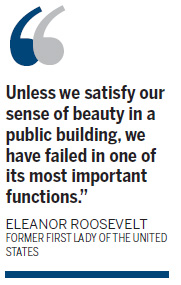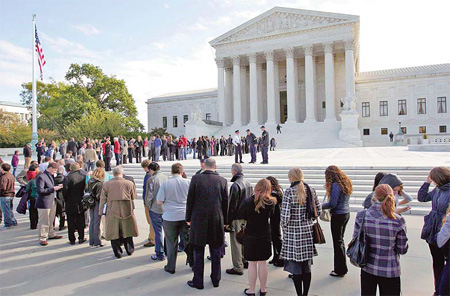Society
Washington closes the door on many entrances
Updated: 2011-01-10 08:06
By Calvin Woodward (China Daily)
|
People wait in line in front of the Supreme Court in Washington on Oct 6. The capital is a city of magnificent front entrances that people can't enter. Carolyn Kaster / Associated Press |

WASHINGTON - The US capital is a city of magnificent front entrances that people can't enter.
On Constitution Avenue, Pennsylvania Avenue and Capitol Hill, sweeping marble staircases, sculptures, manicured gardens and ornate doors beckoned citizens of the past. Now most stand empty and sealed.
The Supreme Court has become the latest to shoo people from its front steps, to the displeasure of several justices who think it's wrong for an open society to close its most majestic portals.
Across the street, the US Capitol now guides visitors into an underground center, clearing steps that the public once climbed. (The stairs feature a column behind which a member of Congress once had a furtive sexual encounter, although, it must be said, just with his wife).
The vanishing welcome of Washington's front doors is evident along most of Constitution Avenue, a thoroughfare and parade route lined on one side by the monuments and grounds of the National Mall and on the other by the headquarters of federal agencies and national or global institutions.
A lone guard on the great lawn of the Federal Reserve says the front is "pretty much off limits" because times have changed. The massive eagle above the entrance looks down on a chain stretching across the staircase and security barriers out by the sidewalk.
A Lonely Planet tour book calls the building a cross between a Greek temple and a Soviet bunker. First lady Eleanor Roosevelt saw ennobling qualities in the modernist Beaux Arts structure when the country was still in depression.
She commented in a 1938 column: "Unless we satisfy our sense of beauty in a public building, we have failed in one of its most important functions. We may not be able to live in houses which give us pleasure, but we certainly should be able to visit our government buildings and feel an esthetic satisfaction. I received that satisfaction from the Federal Reserve Building."
Now, people can tour the Fed only in groups of 10 or more with two weeks' notice or can call two days ahead to visit its art exhibits - all through the side door.
Do-Not-Enter front entrances are very much part of the neighborhood, starting with the American Pharmacists Association building at the western end of Constitution and the adjacent National Academy of Sciences headquarters, where magnolias border walkways from the avenue and old reflecting pools - now planting beds - were once stocked with exotic fish.
A 1937 report by the academy's custodian speaks to an age when citizens had the run of front entrances and much that was inside. Paul Brockett writes about the problem of keeping the building clean when visitors tromped in on damp days, counting 500 before 10 am and 60,000 a year.
Massive bronze doors, embossed with the likes of Aristotle, Galileo, Newton and Darwin, slid open to greet them. Now, the building is closed for renovation.
A block away, the front doors of the Pan American Annex, another Constitution Avenue showpiece, bear signs steering visitors to an entrance by a Dumpster around the corner.
The White House, where Abraham Lincoln was routinely besieged by citizens who strolled uninvited into the mansion seeking jobs, favors, pardons and policies, has long been an iron-fenced fortress due to security concerns. And for more than a decade, cars have been blocked from even driving past on Pennsylvania Avenue.
Few entrances have more historical significance to the nation at large than the 44 broad steps of the Supreme Court. In May, the court closed the main entrance and began steering visitors and those who argue before the justices to the side of the stairway, through new security checks.
The court thus joined a Washington trend that puts it out of step with the world.
"To my knowledge," Justice Steven Breyer said, "no other Supreme Court in the world - including those, such as Israel's, that face security concerns equal to or greater than ours - has closed its main entrance to the public." Justice Ruth Bader Ginsburg added her name to his statement.
There's a back story to the front steps that few people know but everyone is supposed to feel when ascending them.
Breyer, a student of architecture and history, said Cass Gilbert's design created a choreographed, climbing path symbolizing a progression toward justice. The columns, sculptures, 589.68-kilogram bronze doors, Great Hall and finally the courtroom are meant as a journey to that ideal.
People can still leave through those doors and down those steps. But the iconic engraving on high, "Equal Justice Under Law", now is behind their backs.
Associated Press
(China Daily 01/10/2011 page10)
Specials

President Hu visits the US
President Hu Jintao is on a state visit to the US from Jan 18 to 21.

Ancient life
The discovery of the fossile of a female pterosaur nicknamed as Mrs T and her un-laid egg are shedding new light on ancient mysteries.

Economic Figures
China's GDP growth jumped 10.3 percent year-on-year in 2010, boosted by a faster-than-expected 9.8 percent expansion in the fourth quarter.
